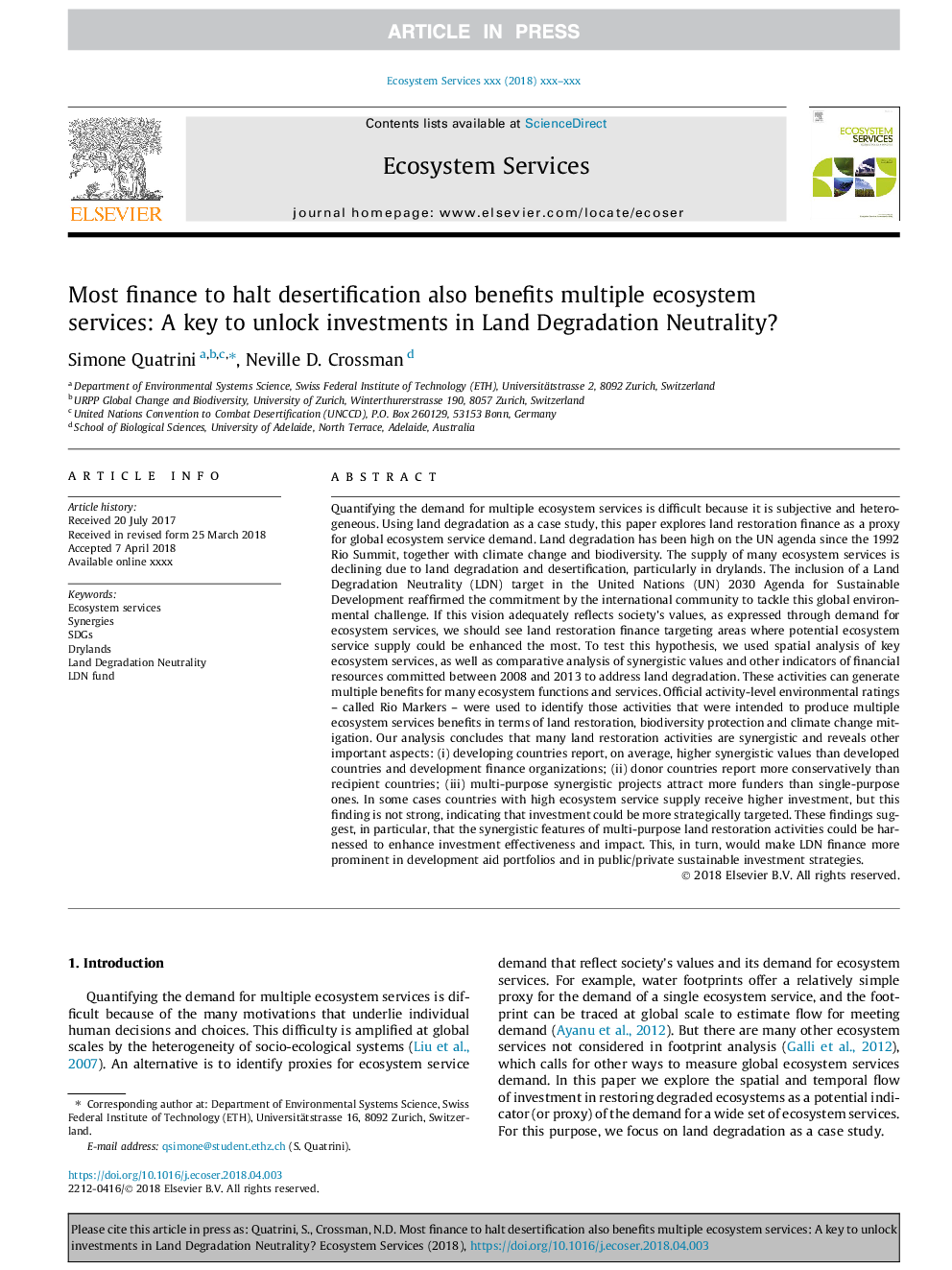| کد مقاله | کد نشریه | سال انتشار | مقاله انگلیسی | نسخه تمام متن |
|---|---|---|---|---|
| 6556293 | 1422523 | 2018 | 13 صفحه PDF | دانلود رایگان |
عنوان انگلیسی مقاله ISI
Most finance to halt desertification also benefits multiple ecosystem services: A key to unlock investments in Land Degradation Neutrality?
ترجمه فارسی عنوان
اکثر امور مالی برای توقف بیابان زایی نیز از خدمات اکوسیستم چندگانه بهره مند می شوند: کلید باز کردن سرمایه گذاری در بی طرفی از دست دادن زمین؟
دانلود مقاله + سفارش ترجمه
دانلود مقاله ISI انگلیسی
رایگان برای ایرانیان
کلمات کلیدی
موضوعات مرتبط
علوم زیستی و بیوفناوری
علوم کشاورزی و بیولوژیک
علوم کشاورزی و بیولوژیک (عمومی)
چکیده انگلیسی
Quantifying the demand for multiple ecosystem services is difficult because it is subjective and heterogeneous. Using land degradation as a case study, this paper explores land restoration finance as a proxy for global ecosystem service demand. Land degradation has been high on the UN agenda since the 1992 Rio Summit, together with climate change and biodiversity. The supply of many ecosystem services is declining due to land degradation and desertification, particularly in drylands. The inclusion of a Land Degradation Neutrality (LDN) target in the United Nations (UN) 2030 Agenda for Sustainable Development reaffirmed the commitment by the international community to tackle this global environmental challenge. If this vision adequately reflects society's values, as expressed through demand for ecosystem services, we should see land restoration finance targeting areas where potential ecosystem service supply could be enhanced the most. To test this hypothesis, we used spatial analysis of key ecosystem services, as well as comparative analysis of synergistic values and other indicators of financial resources committed between 2008 and 2013 to address land degradation. These activities can generate multiple benefits for many ecosystem functions and services. Official activity-level environmental ratings - called Rio Markers - were used to identify those activities that were intended to produce multiple ecosystem services benefits in terms of land restoration, biodiversity protection and climate change mitigation. Our analysis concludes that many land restoration activities are synergistic and reveals other important aspects: (i) developing countries report, on average, higher synergistic values than developed countries and development finance organizations; (ii) donor countries report more conservatively than recipient countries; (iii) multi-purpose synergistic projects attract more funders than single-purpose ones. In some cases countries with high ecosystem service supply receive higher investment, but this finding is not strong, indicating that investment could be more strategically targeted. These findings suggest, in particular, that the synergistic features of multi-purpose land restoration activities could be harnessed to enhance investment effectiveness and impact. This, in turn, would make LDN finance more prominent in development aid portfolios and in public/private sustainable investment strategies.
ناشر
Database: Elsevier - ScienceDirect (ساینس دایرکت)
Journal: Ecosystem Services - Volume 31, Part B, June 2018, Pages 265-277
Journal: Ecosystem Services - Volume 31, Part B, June 2018, Pages 265-277
نویسندگان
Simone Quatrini, Neville D. Crossman,
